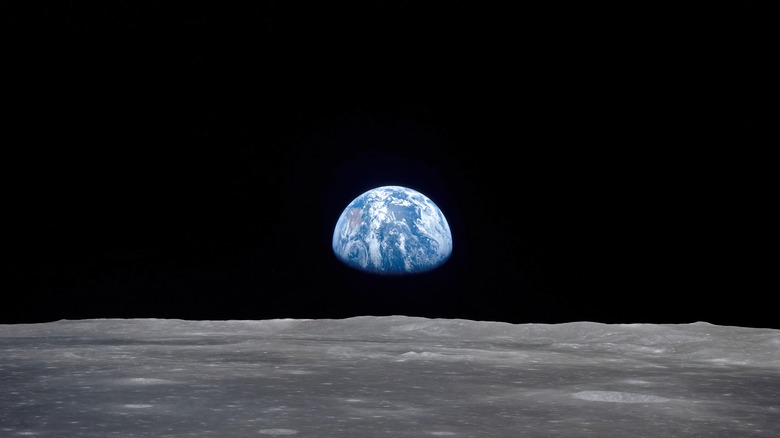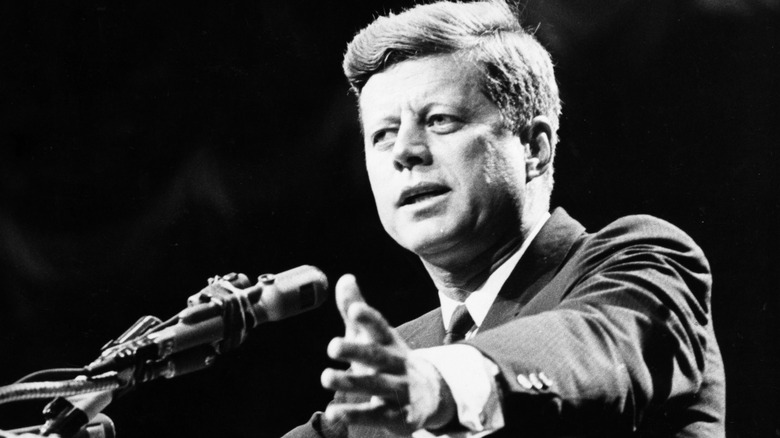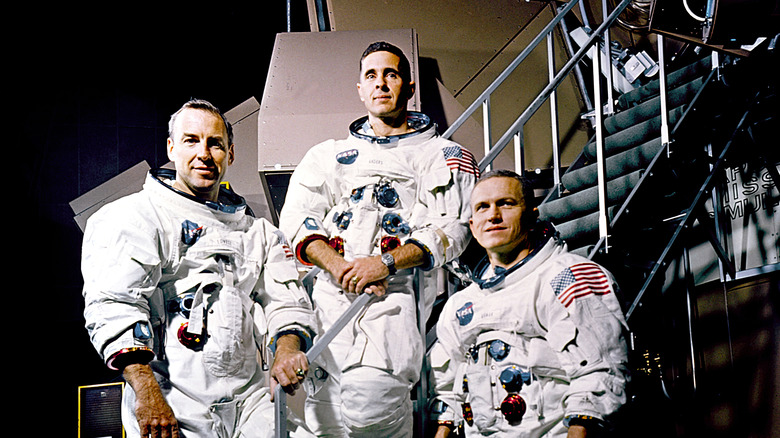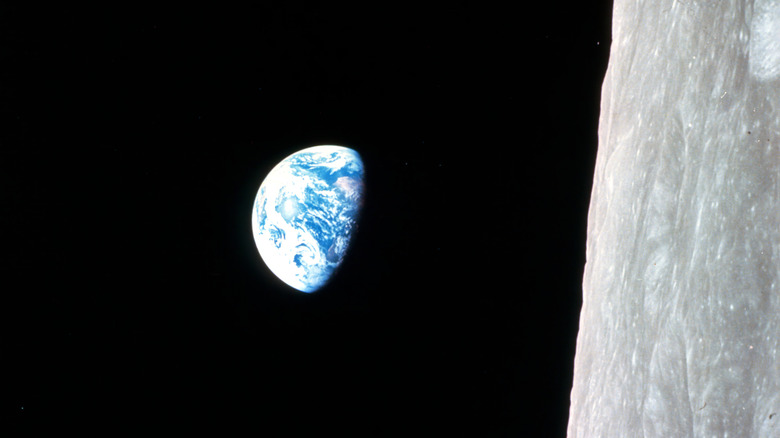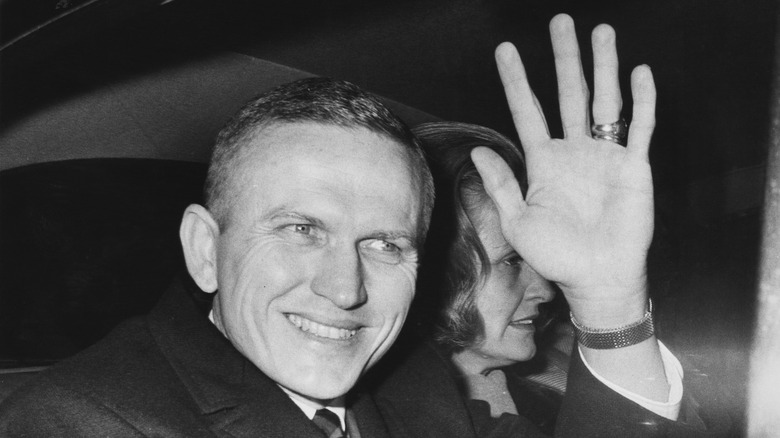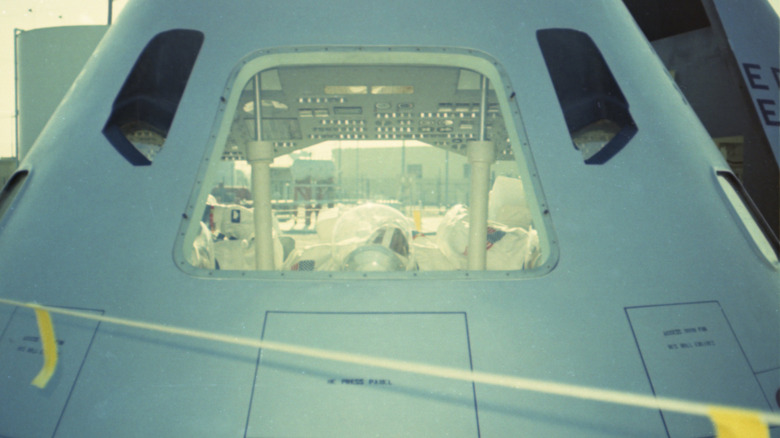The True Story Of William Anders' Famed Earthrise Photo
In 1968, three U.S. astronauts – James Lovell, William Anders, and Frank Borman — were sent into space from Cape Canaveral, Florida, jetted off through the Earth's atmosphere, and journeyed into lunar orbit (via National Geographic). The mission was relatively simple, but massively significant: orbit the moon and return to Earth before the end of the decade to prove the U.S. was fierce competition in the space race. Although many missions had been accomplished before this one, Apollo 8 was the first spaceflight to successfully reach the moon and return home, landing in the Pacific Ocean before the turn-of-the-decade deadline (via NASA).
Although astronauts wouldn't touch down on the moon and leave their footprints until the Apollo 11 mission months later in 1969, Lovell, Anders, and Borman would come back with something tangible that was on par with Neil Armstrong's message delivered on television: a famed photo from the moon's surface with a legacy still being felt today.
A proclamation from the president
Before John F. Kennedy was assassinated in 1963, he made it one of his missions to send astronauts to the moon by the end of the decade. In 1962 during a speech at Rice University, he said, "We choose to go to the moon in this decade, and do the other things. Not because they are easy, but because they are hard."
Surprisingly, the unprecedented journey went fairly smoothly, with only a few course corrections occurring and the launch and landing both proceeding exceptionally well (via NASA). After years of training, the three astronauts were launched into space. In a NASA video, Lovell recalls the day of the launch, saying it was still dark outside in the early hours of the morning: "It suddenly dawned on me this was not another Earth orbital flight. This space rocket was going to take off and we are headed for the moon."
Christmas on the moon
Launching on Dec. 21, the team circled Earth 10 times over the course of 20 hours. Two times while they were orbiting the Earth, the team was able to communicate to mission control back on Earth, and their transmissions were telecast over the radio and television for listeners to hear. One of these was on Christmas Eve, during which the crew read a chapter from the Bible and said to viewers and listeners, "Good night, good luck, a Merry Christmas and God bless all of you — all of you on the good Earth" (via NASA).
According to NASA, millions of citizens around the world tuned into their televisions and radios to watch and listen to the astronauts' journey. "We were told that on Christmas Eve we would have the largest audience that had ever listened to a human voice," said Borman after the fact. "And the only instructions that we got from NASA was to do something appropriate.
Picture perfect moment
While orbiting the Earth, the astronauts were struck by the famous Earthrise that would go on to change history. In the first sighting of the Pale Blue Dot on the horizon, astronauts' reactions to the Earth rising from the Moon's surface were caught on film and later portrayed in a short Time documentary about the moment. "Look at that picture over there," Anders said. "The Earth is coming up... wow! That's pretty."
The crew scrambled for a color film camera to capture the image. Actually, they took a portrait photo and the photo most circulated today has been rotated. As many of us have seen, the blue dome of our planet, its atmosphere, our continents, were suspended in space in a small blue dot. Although satellites had captured images similar to this before, there was something about the human hand holding the camera that inspired awe and wonder across the globe. There we were, suspended in black nothingness, looking oddly fragile and small.
The moon brings hope
At the time, Martin Luther King Jr. and Robert Kennedy had recently been assassinated. The Vietnam War was going on overseas. It was a dark time for people in the U.S. and around the globe. Although Lovell said in the Time video, "We didn't know the significance of the mission with regards to things we did or things we said until we got back home," the challenge posed by Kennedy was a much-needed source of hope and wonder.
"The launch of Apollo 8 brought a binding to the people of our country," Lovell said. "The Earthrise photo in just one picture gives the person a complete understanding and glimpse of his or her position in the universe by looking back at the body she calls home."
Today, the Earthrise photo is still humbling. Similar images are included in the titular footage of the wildly popular "Planet Earth" series, which was created to reconnect people to the plants and animals with whom they share the planet. The U.S. postal service would go on to use it on stamps, and it went on to become one of the most reproduced photographs in history, according to Borman's autobiography, "Countdown."
'There is a Santa Claus'
After completing their orbit, the astronauts were scheduled to head back home on Christmas morning, per NASA. The trip went smoothly, but Kennedy had challenged the team to accomplish this mission before the end of the decade, specifically. With just a few days to spare, there was no time to waste gazing at the beautiful views the team experienced from outer space. The team even launched the mission without a special lunar module because there were delays that "were threatening to slow the Apollo program."
After a smooth trip, mission control "waited anxiously" to hear from the team and see whether the engines were prepared to leave and return back home safely. Finally, continuing in the Christmas Spirit, Lovell came online to tell the folks at mission control that the engines were good to go, saying, "Roger, please be informed there is a Santa Claus" (via NASA).
